Chenyang Zhang
Omni-LIVO: Robust RGB-Colored Multi-Camera Visual-Inertial-LiDAR Odometry via Photometric Migration and ESIKF Fusion
Sep 19, 2025



Abstract:Wide field-of-view (FoV) LiDAR sensors provide dense geometry across large environments, but most existing LiDAR-inertial-visual odometry (LIVO) systems rely on a single camera, leading to limited spatial coverage and degraded robustness. We present Omni-LIVO, the first tightly coupled multi-camera LIVO system that bridges the FoV mismatch between wide-angle LiDAR and conventional cameras. Omni-LIVO introduces a Cross-View direct tracking strategy that maintains photometric consistency across non-overlapping views, and extends the Error-State Iterated Kalman Filter (ESIKF) with multi-view updates and adaptive covariance weighting. The system is evaluated on public benchmarks and our custom dataset, showing improved accuracy and robustness over state-of-the-art LIVO, LIO, and visual-inertial baselines. Code and dataset will be released upon publication.
Transformer Learns Optimal Variable Selection in Group-Sparse Classification
Apr 11, 2025Abstract:Transformers have demonstrated remarkable success across various applications. However, the success of transformers have not been understood in theory. In this work, we give a case study of how transformers can be trained to learn a classic statistical model with "group sparsity", where the input variables form multiple groups, and the label only depends on the variables from one of the groups. We theoretically demonstrate that, a one-layer transformer trained by gradient descent can correctly leverage the attention mechanism to select variables, disregarding irrelevant ones and focusing on those beneficial for classification. We also demonstrate that a well-pretrained one-layer transformer can be adapted to new downstream tasks to achieve good prediction accuracy with a limited number of samples. Our study sheds light on how transformers effectively learn structured data.
Gradient Descent Robustly Learns the Intrinsic Dimension of Data in Training Convolutional Neural Networks
Apr 11, 2025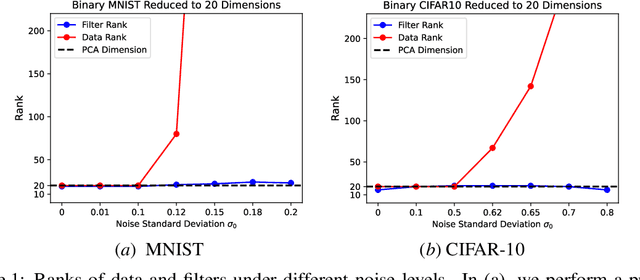
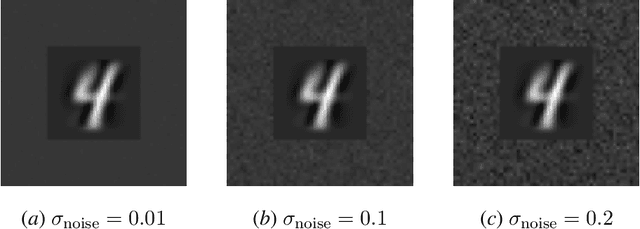
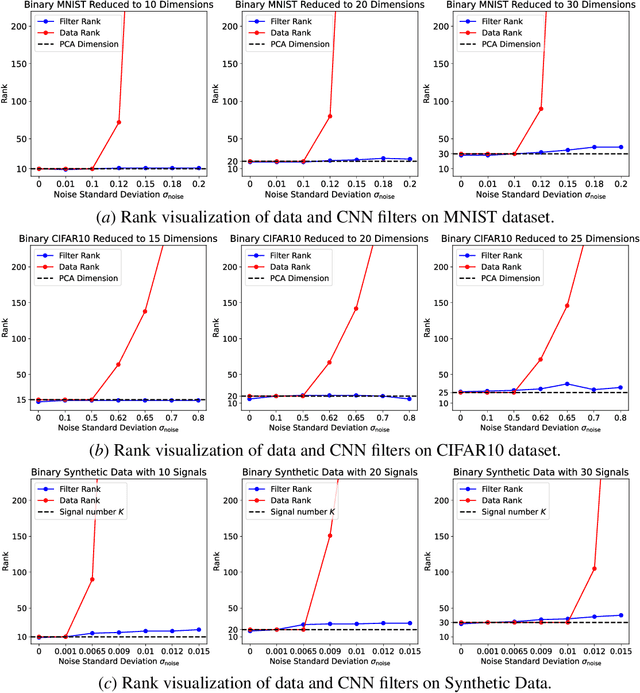
Abstract:Modern neural networks are usually highly over-parameterized. Behind the wide usage of over-parameterized networks is the belief that, if the data are simple, then the trained network will be automatically equivalent to a simple predictor. Following this intuition, many existing works have studied different notions of "ranks" of neural networks and their relation to the rank of data. In this work, we study the rank of convolutional neural networks (CNNs) trained by gradient descent, with a specific focus on the robustness of the rank to image background noises. Specifically, we point out that, when adding background noises to images, the rank of the CNN trained with gradient descent is affected far less compared with the rank of the data. We support our claim with a theoretical case study, where we consider a particular data model to characterize low-rank clean images with added background noises. We prove that CNNs trained by gradient descent can learn the intrinsic dimension of clean images, despite the presence of relatively large background noises. We also conduct experiments on synthetic and real datasets to further validate our claim.
On the Robustness of Transformers against Context Hijacking for Linear Classification
Feb 21, 2025


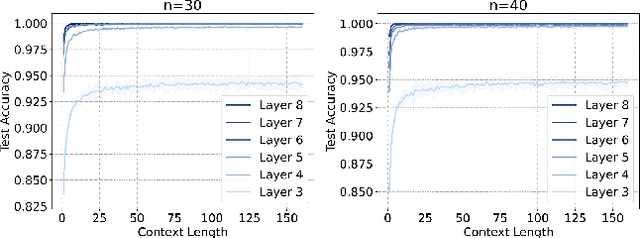
Abstract:Transformer-based Large Language Models (LLMs) have demonstrated powerful in-context learning capabilities. However, their predictions can be disrupted by factually correct context, a phenomenon known as context hijacking, revealing a significant robustness issue. To understand this phenomenon theoretically, we explore an in-context linear classification problem based on recent advances in linear transformers. In our setup, context tokens are designed as factually correct query-answer pairs, where the queries are similar to the final query but have opposite labels. Then, we develop a general theoretical analysis on the robustness of the linear transformers, which is formulated as a function of the model depth, training context lengths, and number of hijacking context tokens. A key finding is that a well-trained deeper transformer can achieve higher robustness, which aligns with empirical observations. We show that this improvement arises because deeper layers enable more fine-grained optimization steps, effectively mitigating interference from context hijacking. This is also well supported by our numerical experiments. Our findings provide theoretical insights into the benefits of deeper architectures and contribute to enhancing the understanding of transformer architectures.
AdaptGCD: Multi-Expert Adapter Tuning for Generalized Category Discovery
Oct 29, 2024Abstract:Different from the traditional semi-supervised learning paradigm that is constrained by the close-world assumption, Generalized Category Discovery (GCD) presumes that the unlabeled dataset contains new categories not appearing in the labeled set, and aims to not only classify old categories but also discover new categories in the unlabeled data. Existing studies on GCD typically devote to transferring the general knowledge from the self-supervised pretrained model to the target GCD task via some fine-tuning strategies, such as partial tuning and prompt learning. Nevertheless, these fine-tuning methods fail to make a sound balance between the generalization capacity of pretrained backbone and the adaptability to the GCD task. To fill this gap, in this paper, we propose a novel adapter-tuning-based method named AdaptGCD, which is the first work to introduce the adapter tuning into the GCD task and provides some key insights expected to enlighten future research. Furthermore, considering the discrepancy of supervision information between the old and new classes, a multi-expert adapter structure equipped with a route assignment constraint is elaborately devised, such that the data from old and new classes are separated into different expert groups. Extensive experiments are conducted on 7 widely-used datasets. The remarkable improvements in performance highlight the effectiveness of our proposals.
Correct after Answer: Enhancing Multi-Span Question Answering with Post-Processing Method
Oct 22, 2024



Abstract:Multi-Span Question Answering (MSQA) requires models to extract one or multiple answer spans from a given context to answer a question. Prior work mainly focuses on designing specific methods or applying heuristic strategies to encourage models to predict more correct predictions. However, these models are trained on gold answers and fail to consider the incorrect predictions. Through a statistical analysis, we observe that models with stronger abilities do not predict less incorrect predictions compared with other models. In this work, we propose Answering-Classifying-Correcting (ACC) framework, which employs a post-processing strategy to handle incorrect predictions. Specifically, the ACC framework first introduces a classifier to classify the predictions into three types and exclude "wrong predictions", then introduces a corrector to modify "partially correct predictions". Experiments on several MSQA datasets show that ACC framework significantly improves the Exact Match (EM) scores, and further analysis demostrates that ACC framework efficiently reduces the number of incorrect predictions, improving the quality of predictions.
A Lightweight Multi Aspect Controlled Text Generation Solution For Large Language Models
Oct 18, 2024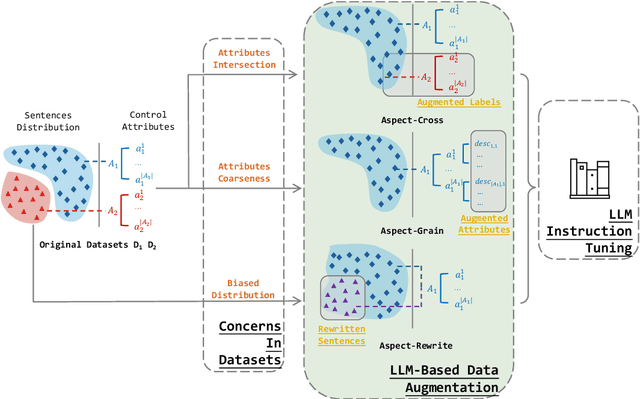

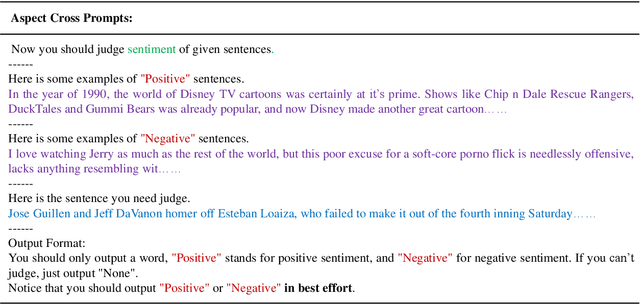

Abstract:Large language models (LLMs) show remarkable abilities with instruction tuning. However, they fail to achieve ideal tasks when lacking high-quality instruction tuning data on target tasks. Multi-Aspect Controllable Text Generation (MCTG) is a representative task for this dilemma, where aspect datasets are usually biased and correlated. Existing work exploits additional model structures and strategies for solutions, limiting adaptability to LLMs. To activate MCTG ability of LLMs, we propose a lightweight MCTG pipeline based on data augmentation. We analyze bias and correlations in traditional datasets, and address these concerns with augmented control attributes and sentences. Augmented datasets are feasible for instruction tuning. In our experiments, LLMs perform better in MCTG after data augmentation, with a 20% accuracy rise and less aspect correlations.
Probing Causality Manipulation of Large Language Models
Aug 26, 2024



Abstract:Large language models (LLMs) have shown various ability on natural language processing, including problems about causality. It is not intuitive for LLMs to command causality, since pretrained models usually work on statistical associations, and do not focus on causes and effects in sentences. So that probing internal manipulation of causality is necessary for LLMs. This paper proposes a novel approach to probe causality manipulation hierarchically, by providing different shortcuts to models and observe behaviors. We exploit retrieval augmented generation (RAG) and in-context learning (ICL) for models on a designed causality classification task. We conduct experiments on mainstream LLMs, including GPT-4 and some smaller and domain-specific models. Our results suggest that LLMs can detect entities related to causality and recognize direct causal relationships. However, LLMs lack specialized cognition for causality, merely treating them as part of the global semantic of the sentence.
The Implicit Bias of Adam on Separable Data
Jun 15, 2024

Abstract:Adam has become one of the most favored optimizers in deep learning problems. Despite its success in practice, numerous mysteries persist regarding its theoretical understanding. In this paper, we study the implicit bias of Adam in linear logistic regression. Specifically, we show that when the training data are linearly separable, Adam converges towards a linear classifier that achieves the maximum $\ell_\infty$-margin. Notably, for a general class of diminishing learning rates, this convergence occurs within polynomial time. Our result shed light on the difference between Adam and (stochastic) gradient descent from a theoretical perspective.
RNG: Reducing Multi-level Noise and Multi-grained Semantic Gap for Joint Multimodal Aspect-Sentiment Analysis
May 20, 2024

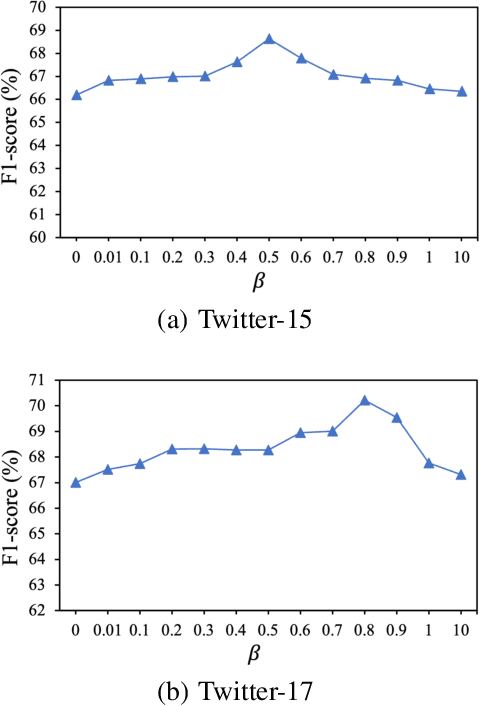
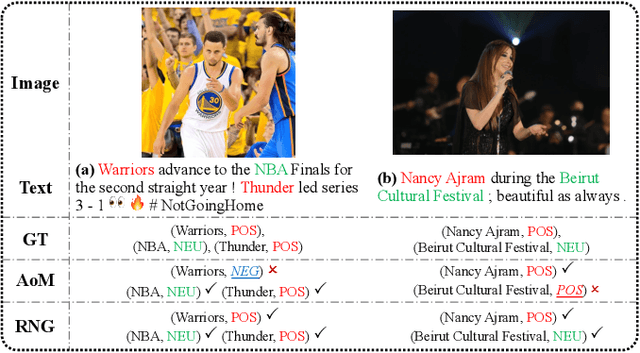
Abstract:As an important multimodal sentiment analysis task, Joint Multimodal Aspect-Sentiment Analysis (JMASA), aiming to jointly extract aspect terms and their associated sentiment polarities from the given text-image pairs, has gained increasing concerns. Existing works encounter two limitations: (1) multi-level modality noise, i.e., instance- and feature-level noise; and (2) multi-grained semantic gap, i.e., coarse- and fine-grained gap. Both issues may interfere with accurate identification of aspect-sentiment pairs. To address these limitations, we propose a novel framework named RNG for JMASA. Specifically, to simultaneously reduce multi-level modality noise and multi-grained semantic gap, we design three constraints: (1) Global Relevance Constraint (GR-Con) based on text-image similarity for instance-level noise reduction, (2) Information Bottleneck Constraint (IB-Con) based on the Information Bottleneck (IB) principle for feature-level noise reduction, and (3) Semantic Consistency Constraint (SC-Con) based on mutual information maximization in a contrastive learning way for multi-grained semantic gap reduction. Extensive experiments on two datasets validate our new state-of-the-art performance.
 Add to Chrome
Add to Chrome Add to Firefox
Add to Firefox Add to Edge
Add to Edge